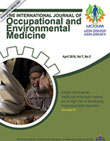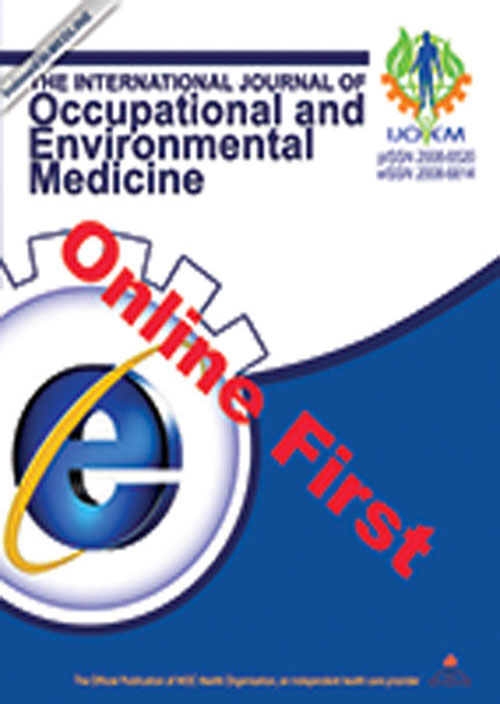فهرست مطالب

International Journal of Occupational and Environmental Medicine
Volume:7 Issue: 2, Apr 2016
- تاریخ انتشار: 1395/06/20
- تعداد عناوین: 7
-
-
Pages 61-78BackgroundThe prevention of work disability is beneficial to employees and employers, and mitigates unnecessary societal costs associated with social welfare. Many service providers and employers have initiated workplace interventions designed to reduce unnecessary work disability.ObjectiveTo conduct a best-evidence synthesis of systematic reviews on workplace interventions that address physical activities or exercise and their impact on workplace absence, work productivity or financial outcomes.MethodsUsing a participatory research approach, academics and stakeholders identified inclusion and exclusion criteria, built an abstraction table, evaluated systematic review quality and relevance, and interpreted the combined findings. A minimum of two scientists participated in a methodological review of the literature followed by a consensus process.ResultsStakeholders and researchers participated as a collaborative team. 3363 unique records were identified, 115 full text articles and 46 systematic reviews were included, 18 assessed the impact of physical fitness or exercise interventions. 11 focused on general workers rather than workers who were absent from work at baseline; 16 of the reviews assessed work absence, 4 assessed productivity and 6 assessed financial impacts.ConclusionThe strongest evidence supports the use of short, simple exercise or fitness programs for both workers at work and those absent from work at baseline. For workers at work, simple exercise programs (12 modal components) appear to provide similar benefits to those using more complex multimodal interventions. For workers off-work with subacute low back pain, there is evidence that some complex exercise programs may be more effective than simple exercise interventions, especially if they involve workplace stakeholder engagement, communication and coordination with employers and other stakeholders. The development and utilization of standardized definitions, methods and measures and blinded evaluation would improve research quality and strengthen stakeholder-centered guidance.Keywords: Exercise, Physical activity, Costs, cost analysis, Efficiency, Presenteeism, Absenteeism, Review [Publication type]
-
Pages 75-86BackgroundPsychologically traumatic workplace events (known as critical incidents), which occur globally, are increasing in prevalence within the USA. Assisting employers in their response is a growing practice area for occupational medicine, occupational social work, industrial psychology and other occupational health professions. Traumatic workplace events vary greatly in their level of organizational disruption.ObjectiveTo explore whether extent of workplace disruption influences organization's decisions for post-incident response planning and plan execution.MethodsAdministrative data mining was employed to examine practice data from a workplace trauma response unit in the USA. Bivariate analyses were conducted to test whether scores from an instrument measuring extent of workplace disruption associated with organizational decisions regarding post-incident response.ResultsThe more severe and disruptive the incident, the more likely organizations planned for and followed through to deliver on-site interventions. Following more severe incidents, organizations were also more likely to deliver group sessions and to complete follow-up consultations to ensure ongoing worker recovery.ConclusionIncreasing occupational health practitioner's knowledge of varying levels of organizational disruption and familiarity with a range of organizational response strategies improves incident assessment, consultation and planning, and ensures interventions delivered are consistent with the level of assistance needed on both worker and organizational levels.Keywords: Workplace, Workplace violence, Occupational injuries, Psychology, industrial
-
Pages 87-97BackgroundMusculoskeletal disorders (MSDs) are among important health problems in working population. Because of performing difficult physical activities, hand-woven shoe-sole makers are at risk of developing various types of MSDs.ObjectiveTo determine the prevalence of musculoskeletal symptoms in different body areas of hand-woven shoe-sole makers, assess workers′ postures and workstations, evaluate ergonomic and individual factors associated with MSDs, and develop guidelines for designing hand-woven shoe-sole making workstation.MethodsIn this cross-sectional study, the prevalence of MSDs symptoms and their risk factors were studied among 240 hand-woven shoe-sole makers. Working posture and workstations were ergonomically assessed as well. The data were collected through interviewing and using Nordic musculoskeletal questionnaire and by direct observation of posture using RULA method. Logistic regression analysis was used to determine risk factors associated with MSDs symptoms.ResultsThe prevalence and severity of MSDs symptoms were high among the study population. Ergonomic factors including daily working time, working posture, and force exertion, as well as individual factors, such as age, job tenure, and education were significantly associated with MSDs symptoms.ConclusionIt seems that the majority of ergonomics shortcomings originate from poorly designed workstation. Some general guidelines for designing shoe-sole making workstation are presented.Keywords: Musculoskeletal diseases, Human engineering, Occupational diseases, Equipment design
-
Pages 98-106BackgroundWork-related musculoskeletal disorders (WMSDs) have been documented among various occupational groups in Nigeria. However, there is limited data on the prevalence of WMSDs among call center operators (CCOs).ObjectiveTo determine the prevalence of WMSDs among CCOs in Nigeria and to explore the extent to which these discomforts impact the daily work activities of the respondents.Methods374 respondents who were randomly selected from 4 telecommunication companies in Lagos State, Nigeria, participated in this study. They were asked to complete a pre-tested questionnaire designed to capture the prevalence, impact and associated risk factors of WMSDs among CCOs.Results42% and 65.2% of respondents experienced at least one WMSDs in the past 7 days, and 12 months, respectively. Women and CCOs who received calls with hand-held phones rather than headsets reported more discomforts during both 7 days and 12 months periods. Neck, shoulder, upper back, and lower back were the most affected areas during past 7 days and 12 months. Discomforts in the neck, low back, and knees prevented most of the respondents from performing their daily work.ConclusionWMSDs have a serious impact on the daily job activities of the CCOs in Nigeria.Keywords: Health impact assessment, Musculoskeletal diseases, Telecommunications, Human engineering, Telephone, Computer terminals
-
Pages 107-115BackgroundOccupational exposure to excessive level of copper results in many adverse health effects.ObjectiveTo measure pulmonary function, oxidative stress, and extent of DNA damage in workers of a copper processing industry.Methods30 men working in a copper processing industry and 30 men matched for age and socioeconomic status (comparison group) were included in this study. Pulmonary function test parameters were measured for all participants. Serum malondialdehyde (MDA), ferric reducing ability of plasma (FRAP), glutathione (GSH) content in RBCs and 8-OHdG were assayed by ELISA. Extent of DNA damage in leucocytes was assayed by comet assay.ResultsPulmonary function parameters, FVC, FEV1, PEFR, and MVV measured in workers were significantly (pConclusionThe observed DNA damage would be due to increased oxidative stress resulting from excessive exposure to copper.Keywords: Lung, Respiratory function tests, Oxidative stress, DNA damage, Copper, Miner
-
Pages 116-122Occupational exposure to elemental mercury vapor usually occurs through inhalation during its utilizations. This leads to a variety of adverse health effects. In some Islamic cities, this type of poisoning may occur during gilding of shrines using elemental mercury with gold. Herein, we report on three male patients aged 2053 years, who were diagnosed with occupational metallic mercury poisoning due to gilding of a shrine. All patients presented with neuro-psychiatric disorders such as anxiety, loss of memory and concentration, and sleep disorders with high urinary mercury concentrations of 326760 μg/L upon referring, 310 days after cessation of elemental mercury exposure. Following chelating therapy, the patients recovered clinically and their mercury concentrations declined to non-toxic level (Keywords: Mercury, Mercury compounds, Mercury poisoning, Occupational exposure, Mercury poisoning, nervous system
-
Pages 123-124


